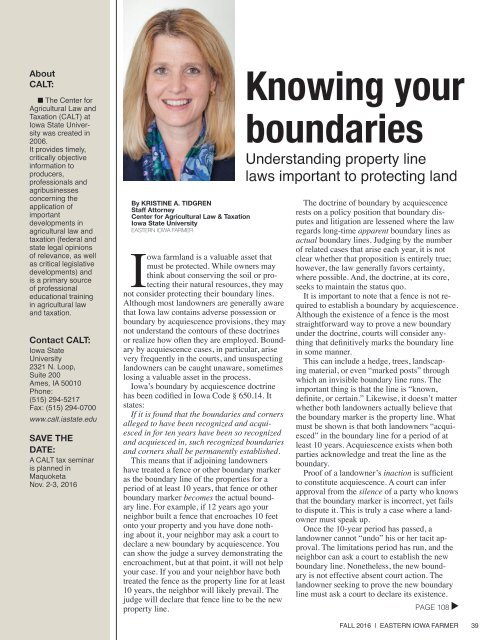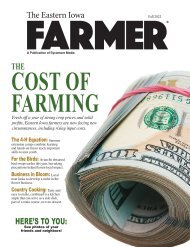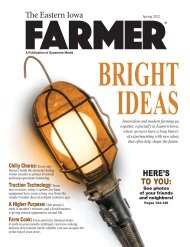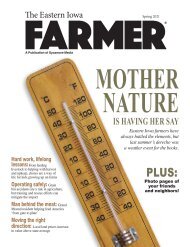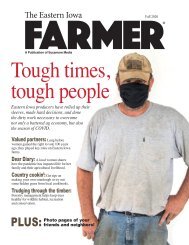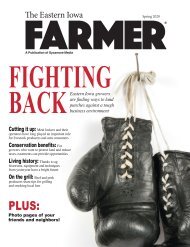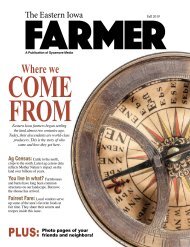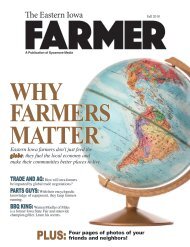You also want an ePaper? Increase the reach of your titles
YUMPU automatically turns print PDFs into web optimized ePapers that Google loves.
About<br />
CALT:<br />
n The Center for<br />
Agricultural Law and<br />
Taxation (CALT) at<br />
<strong>Iowa</strong> State University<br />
was created in<br />
2006.<br />
It provides timely,<br />
critically objective<br />
information to<br />
producers,<br />
professionals and<br />
agribusinesses<br />
concerning the<br />
application of<br />
important<br />
developments in<br />
agricultural law and<br />
taxation (federal and<br />
state legal opinions<br />
of relevance, as well<br />
as critical legislative<br />
developments) and<br />
is a primary source<br />
of professional<br />
educational training<br />
in agricultural law<br />
and taxation.<br />
Contact CALT:<br />
<strong>Iowa</strong> State<br />
University<br />
2321 N. Loop,<br />
Suite 200<br />
Ames, IA 50010<br />
Phone:<br />
(515) 294-5217<br />
Fax: (515) 294-0700<br />
www.calt.iastate.edu<br />
SAVE THE<br />
DATE:<br />
A CALT tax seminar<br />
is planned in<br />
Maquoketa<br />
Nov. 2-3, <strong>2016</strong><br />
By Kristine A. Tidgren<br />
Staff Attorney<br />
Center for Agricultural Law & Taxation<br />
<strong>Iowa</strong> State University<br />
eastern <strong>Iowa</strong> farmer<br />
<strong>Iowa</strong> farmland is a valuable asset that<br />
must be protected. While owners may<br />
think about conserving the soil or protecting<br />
their natural resources, they may<br />
not consider protecting their boundary lines.<br />
Although most landowners are generally aware<br />
that <strong>Iowa</strong> law contains adverse possession or<br />
boundary by acquiescence provisions, they may<br />
not understand the contours of these doctrines<br />
or realize how often they are employed. Boundary<br />
by acquiescence cases, in particular, arise<br />
very frequently in the courts, and unsuspecting<br />
landowners can be caught unaware, sometimes<br />
losing a valuable asset in the process.<br />
<strong>Iowa</strong>’s boundary by acquiescence doctrine<br />
has been codified in <strong>Iowa</strong> Code § 650.14. It<br />
states:<br />
If it is found that the boundaries and corners<br />
alleged to have been recognized and acquiesced<br />
in for ten years have been so recognized<br />
and acquiesced in, such recognized boundaries<br />
and corners shall be permanently established.<br />
This means that if adjoining landowners<br />
have treated a fence or other boundary marker<br />
as the boundary line of the properties for a<br />
period of at least 10 years, that fence or other<br />
boundary marker becomes the actual boundary<br />
line. For example, if 12 years ago your<br />
neighbor built a fence that encroaches 10 feet<br />
onto your property and you have done nothing<br />
about it, your neighbor may ask a court to<br />
declare a new boundary by acquiescence. You<br />
can show the judge a survey demonstrating the<br />
encroachment, but at that point, it will not help<br />
your case. If you and your neighbor have both<br />
treated the fence as the property line for at least<br />
10 years, the neighbor will likely prevail. The<br />
judge will declare that fence line to be the new<br />
property line.<br />
Knowing your<br />
boundaries<br />
Understanding property line<br />
laws important to protecting land<br />
The doctrine of boundary by acquiescence<br />
rests on a policy position that boundary disputes<br />
and litigation are lessened where the law<br />
regards long-time apparent boundary lines as<br />
actual boundary lines. Judging by the number<br />
of related cases that arise each year, it is not<br />
clear whether that proposition is entirely true;<br />
however, the law generally favors certainty,<br />
where possible. And, the doctrine, at its core,<br />
seeks to maintain the status quo.<br />
It is important to note that a fence is not required<br />
to establish a boundary by acquiescence.<br />
Although the existence of a fence is the most<br />
straightforward way to prove a new boundary<br />
under the doctrine, courts will consider anything<br />
that definitively marks the boundary line<br />
in some manner.<br />
This can include a hedge, trees, landscaping<br />
material, or even “marked posts” through<br />
which an invisible boundary line runs. The<br />
important thing is that the line is “known,<br />
definite, or certain.” Likewise, it doesn’t matter<br />
whether both landowners actually believe that<br />
the boundary marker is the property line. What<br />
must be shown is that both landowners “acquiesced”<br />
in the boundary line for a period of at<br />
least 10 years. Acquiescence exists when both<br />
parties acknowledge and treat the line as the<br />
boundary.<br />
Proof of a landowner’s inaction is sufficient<br />
to constitute acquiescence. A court can infer<br />
approval from the silence of a party who knows<br />
that the boundary marker is incorrect, yet fails<br />
to dispute it. This is truly a case where a landowner<br />
must speak up.<br />
Once the 10-year period has passed, a<br />
landowner cannot “undo” his or her tacit approval.<br />
The limitations period has run, and the<br />
neighbor can ask a court to establish the new<br />
boundary line. Nonetheless, the new boundary<br />
is not effective absent court action. The<br />
landowner seeking to prove the new boundary<br />
line must ask a court to declare its existence.<br />
page 108<br />
fall <strong>2016</strong> | <strong>Eastern</strong> <strong>Iowa</strong> <strong>Farmer</strong> 39


